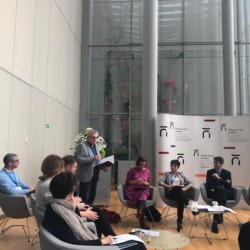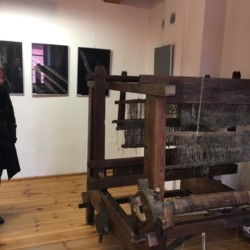FINCH project partners and Stakeholders discussed and jointly looked for the new solutions for financing the cultural heritage in Lodzkie Region (Poland), on the 23th – 24 th of October, 2019 within the Vth International Workshop aimed at presenting the following good practices in this area:
– The Arthur Rubinstein Philharmonic in Lodz
(https://filharmonia.lodz.pl/en/)
The Arthur Rubinstein Philharmonic in Lodz was presented by its director – Mr. Tomasz Bęben – with particular reference to his longer than 20-years-long experience in managing the cultural heritage protection related activities. The Philharmonic was renovated within the Regional Operational Programme for the Lodzkie Region for the years 2007-2013 with the European Regional Development Funds co-financing, which was a huge trigger to its great further development. Thanks to this, the philharmonic can also boast of original nineteenth-century organs. The philharmonic is trying to meet the needs of a wide audience, conducting projects not only for demanding publicity, but also targeting in other groups, like children and general public, and also throughout the region, organizing the Traveling Festival „Colors of Poland”; in Lodzkie Region, for example. This festival, combines the opportunity to visit the most interesting parts of the region with the opportunity to meet and listen to outstanding artists, provides the possibility to visit the touristic attractions of the region, feel an even stronger bond with it, and people with a tourist or historical eagerness are able to participate in unique concert events crowning each of the trips. (in 2019 the 20th edition was organized).
− Cultural Park: “Town of Weavers”
(http://www.miastotkaczy.pl/);
This cultural park is composed of several weavers’ houses dating back to the 19th century. The region has been heavily focused on the textile industry, which in the 19th century had developed because of the favorable chemical composition of its water. The buildings were moved there from different parts of the town and have become part of the ‘Town of Weavers’ cultural park. Currently there are 23 well-preserved weavers’ houses including the tourist’s house, Wood Conservation Center, administrative offices, hostel and restaurant. In addition, the project also includes tree planting and landscaping of the surrounding streets to give visitors the feeling of being taken back in time. Today the ‘Town of Weavers’ hosts various cultural events and attracts both tourists and the region’s citizens. It promotes textile traditions and the history of the Lodzkie Region.
− Museum: Radziwiłł Palace in Nieborów and Romantic Park in Arkadia
(http://www.nieborow.art.pl/en/about-the-museum/);
The Museum was set up in 1945, it includes Radziwiłł’s Palace and Garden in Nieborów and Romantic Garden of Helena Radziwiłł in Arkadia. Till the end of January 1945, both, the Palace in Nieborów and the Garden in Arkadia, were a part of the estate of Duke Janusz Radziwiłł, the lord of Ołyka and the owner of Nieborów–Mysłaków lands. However, in February 1945 the whole Radziwiłł family was deported by NKVD into the Soviet Union to the labour camp in Krasnogorsk. Just after that happened, Stanisław Lorentz, then the Director of National Museum in Warsaw, fullfilling earlier agreement with Radziwiłł, made the unique Palace in Nieborow together with the whole collection of its goods and the Arkadia’s Garden a part of Warsaw’s National Museum, which saved them from the devastation in the period of orthodox stalinism. Nowadays, Nieborów is the residential museum of interiors from the period of 17th to 19th century. The museum exhibits furnishings and collections of sculpture, paintings, bronzes, silvers, porcelain, glass, clocks and books. It was also supplemented by the works of both fine and decorative arts from collection of National Museum in Warsaw. Palace and the regular (French) Garden in Nieborów as well as English (Romantic sentimental) Garden in Arkadia were renovated and made available for visitors as Palace-Garden Residence. Moreover, in 1945 the Creative Works Centre for writers, artists and scientists was founded within the museum. Nieborów Museum serves also as the venue for international conferences and diplomatic meetings.
− European Institute in Lodz – formerly Schweikert Residence
(http://www.ie.lodz.pl/);
Partners had the opportunity to familiarize with the history and some projects conducting by this organization. The European Institute was established as a non-profit Foundation in 1993. The Institute’s history is linked to Poland’s opening up and getting closer to European structures, as its creation was aimed at supporting the process by delivering statutory tasks, such as: research, training, education, publications, dissemination of information and promotion of European ideas. The headquarter of the Institute is historic building – Robert Schweikert Palace, which is listed in the Regional register of monuments. The Institute benefits a lot from the growing in the region film industry – renting spaces for the needs of many film adaptations.
− MS1 – Art Museum in Lodz
(https://msl.org.pl/en/ms/for-visitors/ms1-en,87.html).
MS1 is one of the oldest museums of modern art in the world. The museums’ mission is „providing an appropriate environment for contemporary audiences to interact with the heritage of past and present generations of artists which can inspire them to develop the ability to independently see, understand and experience the world around”;. The Museum promotes art as a valid component of social life which makes the human existence more complete and valuable. This mission goal is pursued by collecting, preserving and studying works of art, as well as by organizing artistic events and supporting and advancing research, education and promotion of art at all levels.
The next FINCH project meeting will be organized in Region of Thessaly (Greece) in
the new year. https://www.interregeurope.eu/finch/
Lodzkie House https://bruksela.lodzkie.pl/
Gallery



